Despite the ballyhooed holy war between BYU and the U of U on the playing field, in scores of research ventures the universities have become fast allies.
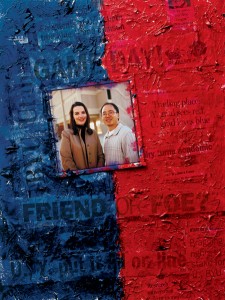
Paleobiologists are typically unaccustomed to the side effects of working with live animals. As specialists in fossilized beasts, they normally encounter animals and their by-products as still-life art, frozen in rock. So when University of Utah paleobiologists teamed with BYU animal biologists, they had a few things to learn.
“Our U of U collaborators have found that sandals are not appropriate foot attire for a barnyard,” laughs BYU assistant professor of integrative biology Todd F. Robinson, ’86. “It’s been amusing to hear lab scientists, ending a sample-collection session, ask, ‘What’s that awful smell?’ They later realize it’s them!”
Scented missteps notwithstanding, the collaboration between neighboring biology departments has proved fruitful. Studying the effects of diet on animals—living and extinct—the scientists have published nine articles (with three more in review) and have presented seven abstracts at national scholarly conferences in the last five years. Many of these publications include undergraduate students as coauthors.
Collaborations such as this one abound on the Wasatch Front, despite tensions—however impassioned—in the athletic arena. More than 60 collaborations thrive between BYU and the University of Utah, ranging from full-fledged, federally funded undertakings to more modest minglings of ideas and resources.
Certainly, the academic atmosphere between the universities is extremely friendly, facilitated by the transplanted school presidents: BYU’s President Cecil O. Samuelson is a graduate of and former administrator at the U, and Utah’s new president, Michael K. Young, ’73, graduated from B.Y. High as well as BYU and is a distant relative of Brigham Young, who founded both universities.
Since assuming their posts, both presidents have discussed, encouraged, and supported the idea of greater collaboration between their universities.
“The sharing of thoughts and ideas is important in that it sometimes provokes or supplements new and better thoughts and ideas,” says President Samuelson. “Through collaboration, higher levels of understanding can be reached more rapidly. Importantly, these new discoveries are usually accompanied by a spirit of excitement that then fosters further growth and comprehension.”
Similarly, President Young is a believer that two heads are better than one.
“But I also acknowledge that resources are scarce,” President Young says. “Collaboration helps maximize those resources. The U needs to look for ways to employ Y resources—financial, administrative, intellectual, or otherwise—so that they enhance the U in ways that don’t diminish the Y, and vice versa.”
At first, the idea of mixing Cougar blue with Runnin’ Ute red may seem out of place, but in the academic world, the combination is a natural fit that has led to increased opportunities for student and faculty growth while expanding the body of knowledge.
Tag-Team Mentoring
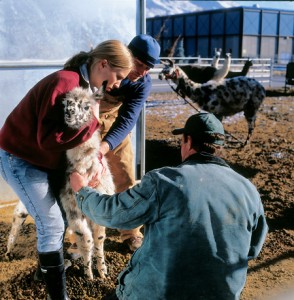
Some collaboration can be done at a distance, via e-mail and telephone calls. But when your research calls for the collection of goat breath, you really must get up close and personal.
Since 2000, Robinson and Beverly L. Roeder, BYU professor of integrative biology, have been collaborating with U scientists Thure E. Cerling, James R. Ehleringer, and Maria-Denise Dearing. Every few months the group gathers at BYU’s farming facility. Amid the bleats and neighing of their research subjects, which also include horses, llamas, cows, and pigs, the researchers seek to “answer questions about diet reconstruction that until now have only been speculated and assumed,” Robinson says.
With syringes attached to paper drinking cups, they gather samples by holding the cups over the animals’ mouths. When the syringes are filled with exhaled air, they are quickly sealed for mass-spectrometry analysis at a U facility.
“There is carbon in the breath of every animal, and different foods create different carbon signatures,” Robinson says. “By doing mass-spectrometry analysis of the breath, we can determine the nature of diet changes and monitor nutrition.”
The BYU team is interested in determining how nutrients from alfalfa hay are incorporated into an animal’s breath, teeth, bone, hair, blood, and various organs. U scientists are using the live animal information in coordination with fossil findings to reconstruct what fossilized animals ate.
“We share everything—data, samples, time, expertise, and our labs,” says Robinson. “We each bring intellectual and practical expertise to the collaboration—our expertise in animal biology with the U’s paleobiology and mass-spectrometry proficiency.”
The complementary specialties of the two teams not only provide helpful synergy in research, they also open up new fields of education for student researchers. “We collaborators trade students around to afford them the opportunity to work in other labs and increase their skill base,” Robinson says.
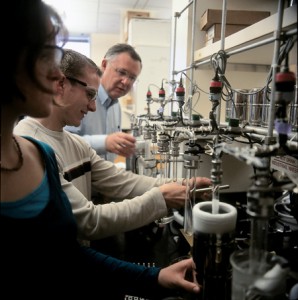
U of U biologist Ehleringer agrees: “Together we can provide a combination of training for students in the biological sciences that neither of us could provide alone.”
Further augmenting the mentoring possibilities, the collaboration has grown from its U of U/BYU roots to include scientists from the universities of Bristol, Oxford, Cambridge, Bradford, Cape Town, and Colorado at Boulder.
“We have brought together scientists from universities across the world who bend over backward to help junior faculty and students succeed,” says Robinson. “Collaborations are the best way I know to mentor our undergraduates because of the opportunities they provide them to work with researchers of other mindsets, philosophies, and approaches to answering questions.”
Mentoring and creating relationships can be a valuable aspect of collaborations—for faculty as well as for students. BYU associate professor of family life Christin L. Porter, ’90, for instance, has improved his reputation as an up-and-coming researcher thanks to his work with the U’s Alan D. Fogel, a professor of psychology.
“My colleagues know Dr. Fogel as a formidable scholar of developmental psychology and have been encouraging and respectful of our collaborative efforts,” Porter says. “And although I would classify my collaboration with him as modest, working with an expert of his stature has already helped make my work more visible.”
Porter and Fogel, each at their respective labs, regularly observe mothers and their children as they play with blocks, balls, stuffed animals, and dolls. Behind mirrored glass, the researchers observe and document facial reactions, body language, changes in vocal tone, and other cues that give them insight into the ways dynamic relationships are formed and how these relationships influence healthy growth and development.
“Many families are concerned about this topic and want a better understanding of relationship dynamics, even in infancy, that promote good outcomes,” says Porter, whose research focuses on “attachment relationships,” an early bond that develops out of a history of responsive caregiving, trust, and shared emotional experiences. “Children who develop secure attachment relationships have been found to enjoy a number of advantages, including more stable emotionality, greater problem-solving abilities, more social leadership skills among peers, and healthy relationships.”
Fogel and Porter’s collaboration began when Porter took BYU students to Fogel’s lab to learn the coding system he developed for tracking the information gathered during parent-child interactions. Since then, their work has developed mostly into the sharing of data and ideas, as the two e-mail one another and meet together at professional conferences to discuss matters further.
Fogel returns admiration for Porter’s work and the skills he brings to their collaboration.
“Dr. Porter is a thoughtful and careful researcher and an excellent mentor,” says Fogel. “I appreciate how he has brought his students into close contact with research and fostered their career development.”
Two Universities Are Better than One
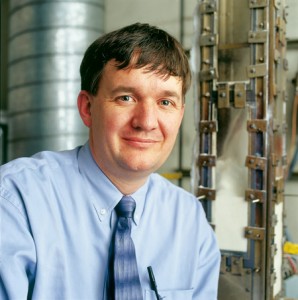
BYU chemical engineering professor Larry L. Baxter, ’83, likes to burn things, and his friends at the U like to join in the fun.
“I’m a Scoutmaster,” says Baxter. “My Scouts think I have a dream job.”
An expert in the field of biomass research—which investigates the use of plant material and agricultural waste as energy sources—Baxter lights all sorts of things on fire. Straw, sawdust, nutshells, fruit pits, and skin from peas are all victims to the flame in his quest to find affordable and efficient ways to generate electric power and transportation fuel.
One of his major areas of collaboration with U faculty involves black-liquor processing, a by-product of pulp manufacturing in paper mills. “People sometimes quip about which of the campuses is more receptive to such a material,” Baxter says.
Studying combustion, he explains, mostly involves examining “leftovers,” or impurities in the burning process, like pollutants and ash. Although they are relatively minor products of the process, they can have a large impact on the environment.
Combustion collaboration between the two universities usually involves one school’s researchers developing a computer model or conducting an experiment on a small scale and then sending the model or experiment to the other school to test the model in the real world or replicate the experiment on a larger scale.
“In many ways, I think of the U’s facilities as an extension of my own laboratory,” says Baxter, explaining that he and U scientists alternate making the commute to each other’s campus every couple of weeks.
One colleague, U of U research associate Kevin J. Whitty, used to work for a company in Sweden that was trying to commercialize a technology for black-liquor gasification. Baxter suggested Whitty come to Utah and work as a collaborator at the U, which he eventually did.
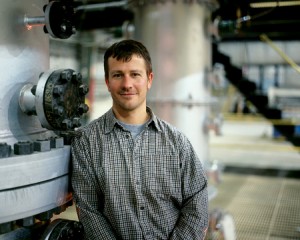
“We have a common interest in the power production from biomass and black liquor, so it is a natural fit for us to work together,” Whitty says. “I’m a big fan of collaboration because no one single place has all the intellectual knowledge or resources to solve the kind of problems we’re working on. BYU has certain types of equipment and personnel that are very good and complement what we’re working on at the U.”
More perspectives and ideas are prime benefits for collaborative researchers. BYU assistant psychology professor Julianne Holt-Lunstad, ’94, and U of U psychologists Timothy W. Smith and Bert N. Uchino are working to clarify the health consequences of interpersonal interactions of hostile individuals.
“Collaboration is critical,” Holt-Lunstad says, “especially in a field such as mine, in which the phenomenon we are interested in is, by nature, interdisciplinary. I’ve found that through collaboration we come up with better ideas than any of us would have come up with individually.”
Recently presented at the summer conference of the American Psychological Association, the scholars’ work suggests that hostile individuals may not be able to benefit from social support offered by friends during stressful events like divorce or loss of employment.
The research has health implications, since friends, who offer emotional support, tend to provide a “buffering effect” from the negative effects of stress. Too much stress is linked to high blood pressure, which leads to heightened cardiovascular risk, says Holt-Lunstad, who did her undergraduate work at BYU and her doctoral work at the U.
Both Baxter and Holt-Lunstad cite the U’s research expertise as a strong draw for BYU collaborators. In addition to having a wealth of facilities, the U receives significantly more research funding than does BYU. “BYU’s primary mission is undergraduate education, and we do research at BYU as part of this mission,” says Baxter, who has involved more than 100 undergraduate students in his research during four years at BYU. “The U encourages a more traditional university research model that is not necessarily tied to undergraduate education.”
Above the Fray
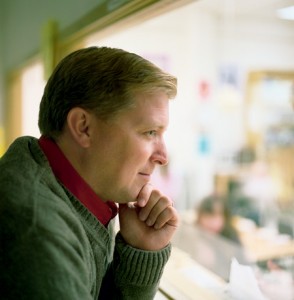
Holt-Lunstad may have the most appropriate collaborative research between Cougar and Ute professors, but her hostility studies have not exactly reduced the Wasatch Front sports rivalry. “I’ve gone to watch the BYU/U of U football game at my collaborator’s house, and there may have been a few hostile exchanges,” laughs Holt-Lundstad. “One time I showed up to the annual party he has, and the U was ahead. Suddenly, the tide turned, and the Y ended up winning the game. The Ute fans thought afterward that maybe they shouldn’t have invited me.”
Baxter says the sports rivalry doesn’t interfere with his working relationships—at least it hasn’t yet. Baxter’s U colleague Whitty says he has exercised perhaps too much restraint in joking with Baxter: “Now that the U’s football team is doing so well, I realize that I don’t tease Larry enough. It hasn’t always been that we’ve had such a good team. I’ll try to do a better job of that.”
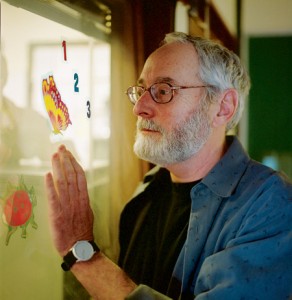
Friendly teasing aside, all BYU researchers agree that their collaborations with Ute rivals have been invaluable. “Collaboration, I believe, is often a critical part of the discovery process,” says Porter, citing research duos like Watson and Crick of DNA fame. “When I think of some of the greatest discoveries of our age, most extend from collaborative efforts.”
There can be power, wisdom, and innovation in teamwork, say BYU researchers—and perhaps a little more. Robinson says the animal biology collaboration in the field has softened his heart toward his Ute brethren on the field. “Now, just to be clear—when it comes to a game between BYU and the U, I am blue through and through,” says the avid sports fan with a smile. “But it’s true: more and more I find myself rooting for them when they play ball.”
Grant Madsen is a media-relations manager for BYU’s University Communications.
Feedback: Send comments on this article to magazine@byu.edu.
Related Articles: A Cougar Running the Utes and The Presidential Swap






